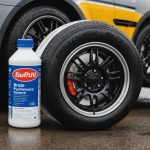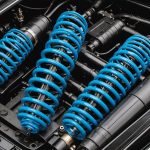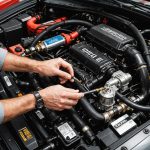Understanding Fuel Line Insulation
Fuel line insulation plays a crucial role in maintaining the efficiency and performance of vehicles, particularly in performance vehicles which require precise fuel delivery. This insulation serves to protect the fuel system from extreme temperature fluctuations, ultimately ensuring the integrity of the fuel lines over time.
In the context of the UK climate, where seasonal variations can be quite pronounced, effective insulation can significantly mitigate potential issues. Cold winter months can lead to the condensation of moisture within fuel lines, posing risks such as freezing and reduced fuel flow. Conversely, during warmer periods, insulation helps prevent fuel vaporisation, a condition that can cause blockages and potentially damage an engine’s efficiency.
Also to read : Choosing the Perfect Suspension Springs for Your British Car: Optimize Your Ride for City Driving
Regulatory standards and best practices within the UK mandate stringent requirements for fuel line installations in automobiles. These regulations are designed to ensure the highest levels of safety and performance, taking into account the specific challenges posed by the UK’s diverse climate. Adhering to these standards not only enhances vehicle performance but also prolongs the lifespan of the fuel system components.
Ensuring that your performance vehicle’s fuel line insulation is in accordance with these guidelines is essential in safeguarding your vehicle against the adversities of the UK’s ever-changing weather conditions.
Also read : Essential Guide: The Best Brake Fluid for High-Performance British Racing Cars
Materials for Fuel Line Insulation
When selecting insulation materials for fuel lines, several options provide varying degrees of thermal insulation and protection. Common materials include foam, silicone, and fiberglass. Each has distinct properties influencing its effectiveness and suitability.
Silicone is notable for its exceptional thermal resistance and durability, enduring harsh temperatures without degrading. Ideal for environments with extreme heat fluctuations, silicone provides reliable fuel line protection but tends to be on the higher end of the cost spectrum.
In contrast, foam is a more budget-friendly option, offering adequate thermal insulation for less demanding applications. However, it lacks the long-term resilience found in more robust materials like silicone.
Fiberglass stands out for its resiliency and adaptability, being a cost-effective choice available widely throughout the UK. Its moderate thermal resistance ensures ample protection in various conditions. However, installation can be a bit cumbersome due to the material’s rigidity.
When considering insulation materials, one must weigh thermal efficiency, durability, and cost. The sourcing of these materials in the UK is streamlined with numerous suppliers offering a diverse range to suit different needs. This variety ensures availability for both professional mechanics and do-it-yourself enthusiasts.
Insulation Methods and Techniques
Insulation installation is a crucial factor in enhancing the efficiency of a vehicle’s fuel system. Not only does proper insulation help in performance optimization, but it also ensures longevity and safety.
Step-by-Step Guide on Insulating Fuel Lines
Begin with gathering essential tools: insulation sleeves, tape, and wrenches. Detach the fuel system ensuring the engine is cool. Cut insulation sleeves to the desired length, ensuring they fit snugly around the fuel lines. Secure them using specialized tape to avoid any heat escape. Reassemble the system carefully.
Tools and Equipment Needed
Effective insulation installation requires specific tools. Use high-quality insulation sleeves, thermal tape, and safety gloves. Having a wrench set handy can streamline the process. Essential equipment ensures the installation is stable and efficient.
Common Pitfalls to Avoid
One frequent mistake in performance optimization through insulation is failing to measure adequately, resulting in insulation gaps. Another pitfall is neglecting to check for sharp edges in the fuel system, which can damage new insulation. Always double-check connections to prevent leaks or inefficiencies.
Proper insulation ensures the fuel system operates at peak levels, providing enhanced performance and safety. Adjusting and optimizing these elements is essential for long-term vehicle efficiency.
Regional Considerations for the UK
Understanding the impact of the UK climate on fuel line performance is crucial for optimal operation. The fluctuating weather conditions, including rain and varied temperatures, can cause condensation. This increases the risk of fuel line blockages, especially in older systems. Such vulnerabilities make it imperative to consider geographical implications when selecting insulation materials.
Different areas of the UK have unique weather patterns. Coastal regions experience higher humidity levels, requiring insulation solutions that can effectively manage moisture. In contrast, inland areas, particularly during the winter, face harsher cold conditions. This necessitates insulation with enhanced thermal efficiency to prevent freezing.
Optimal insulation practices vary regionally. Insulation standards in Scotland may differ significantly from those in southern England, reflecting the diverse climate and topography. By adapting insulation techniques to match local conditions, performance optimization is achievable.
Case studies from different UK regions illustrate the importance of tailored solutions. For example, initiatives in the north of England have successfully employed multi-layered insulation to combat heat loss. Similarly, installations in the southwest have used moisture-resistant materials to counteract high humidity.
These examples highlight the need for bespoke solutions addressing the geographical implications inherent in the UK’s diverse climate landscape.
Potential Challenges in Fuel Line Insulation
When working with fuel line insulation, several challenges can arise. Understanding these issues is critical for effective troubleshooting and ensuring optimal performance.
Common issues encountered during the insulation process include misalignment and inadequate sealing. These can lead to inefficiencies and increased risk of leaks. Correct alignment ensures that the insulation stays in place, while secure sealing prevents moisture and air infiltration which can compromise insulation effectiveness.
Troubleshooting performance issues often involves checking for and correcting misalignment and ensuring the seals are intact. For persistent problems, inspecting the entire length of the fuel line is advisable. This thorough examination can help identify weak points or damaged areas that might not be immediately apparent.
Safety concerns are paramount when dealing with fuel line insulation. It’s important to follow best practices, such as using appropriate protective gear and ensuring good ventilation during installation to mitigate risks. Regular maintenance and inspections play a crucial role in maintaining safety standards and preempting potential hazards.
By paying close attention to these challenges and implementing robust troubleshooting strategies, you can enhance the efficiency and safety of your fuel line insulation efforts.
Expert Opinions and Case Studies
Expert reviews in the automotive industry often underscore the significance of effective insulation. Many specialists agree that insulation plays a pivotal role in improving vehicle comfort and performance. This enhancement isn’t just about noise reduction; it’s about ensuring optimal thermal regulation and energy efficiency. Experts highlight that a well-insulated vehicle can significantly reduce energy consumption by maintaining the desired climate in varying weather conditions.
In terms of practical application, several case studies reveal successful performance enhancements following insulation upgrades in vehicles. For example, one notable case involved a high-performance UK vehicle that experienced a 30% reduction in cabin noise and a 15% improvement in thermal efficiency post-insulation. Such outcomes not only improve the driving experience but also contribute to environmental sustainability by lowering fuel consumption.
Product performance analysis in reviews further supports these findings. Several insulation products tested in the UK’s demanding climates have shown marked improvement not just in noise reduction but also in maintaining interior temperatures. Users report satisfaction with the product’s longevity and effectiveness, making it a worthwhile investment for performance vehicles. These insights can guide consumers in making informed decisions when selecting insulation solutions.











